No, absolutely no. It is on the fish skin.That's a big spot. I thought it was a blemish on the pic.
Navigation
Install the app
How to install the app on iOS
Follow along with the video below to see how to install our site as a web app on your home screen.
Note: This feature may not be available in some browsers.
More options
You are using an out of date browser. It may not display this or other websites correctly.
You should upgrade or use an alternative browser.
You should upgrade or use an alternative browser.
Ich eradication vs. Ich management
- Thread starter Humblefish
- Start date
- Tagged users None
I've read this as well. However, since most (but not all) who practice ich management don't QT then it's likely another fish with ich will be introduced into their DT; and probably with a different strain of ich. That diversifies the gene pool and takes care of the inbreeding problem. Or at the very least, restarts the 10-12 month clock.
A given strain of ich will die out after about 4 years, on average. However, if you introduce a new strain of ich from not QTing the cycle starts all over.
@Humblefish just interested to know where you have read about ich strains dying out over time? Did you find new research between the above two posts that pushed the timeframe from 10-12 months to a 4 year average?
Thanks
Nick
#reefsquad Running copper. You can run 14 day therapeutic, then trasfer to sterile tank. Or run 30 days in same tank then remove copper.
Question may be stupid, but if you have a sterile tank to move fish to. You can do so anytime between end of 14th day and 30th day, doesnt matter when?
Question may be stupid, but if you have a sterile tank to move fish to. You can do so anytime between end of 14th day and 30th day, doesnt matter when?
HotRocks
Fish Fanatic!
View Badges
Staff member
Super Moderator
Excellence Award
Reef Tank 365
Expert Contributor
Article Contributor
INDMAS Member
My Tank Thread
Correct. Anytime post 14 days therapeutic copper is fine.#reefsquad Running copper. You can run 14 day therapeutic, then trasfer to sterile tank. Or run 30 days in same tank then remove copper.
Question may be stupid, but if you have a sterile tank to move fish to. You can do so anytime between end of 14th day and 30th day, doesnt matter when?
Ich/velvet only remain on the fish itself for up to 7 days. The extra 7 days is insurance. The copper shields the fish from reinfection.
Here's the thing about ich-- it is indeed a parasite but the infestation of an aquarium full of fish is a dynamic. I mean that a combination of factors come together to cause an infestation. In some tanks ich can be lurking for a very long time but staying in such low numbers it is a minor problem ( or appears to be). Many hobbyist report that 'ich' keeps coming back and this is that is the reason. Indeed very healthy looking fish can carry a minor population of ich in the recesses and curves of their body. Terms like 'stress ich' and 'resistant ich' are used to try and explain this spontaneous ramping up of small populations into infestations. Having said this, it is possible to eradicate all with Hyro ( 1002-1010 SG) and light copper. The range of SG depends on species as some species do not do as well as others. And do realize that species like mandarins will be deprived of their live food if they even live thru this as all small creatures will be killed as well. If the infestation is heavy expect to loose 10%-25% of the fish population. If you are early you shouldn't loose any. So if you really want to end the parasite and then keep it eliminated for ver do this : 1) realize you will be doing a lot of work for about 8-21 days-) begin doing water changes ( ideal to vacuum sand for the water that you change as the cyst stage is in the substrate) 3) do as much as 20-30% water changes with clean RO/DI ( pH matched and Temperature warmer, just remember the warmer the water the less the oxygen held and the fish with ich on the gills are already struggling, so warm the tank by just a few degrees. Important: each freshwater mix you add should have a therapeutic dose of cooper in it. That is to say, the freshwater will have a full recommended dose of copper but when it is added to the tank it will dilute to below a therapeutic dose. 4) after a few days of doing this, your SG should be down to 'wear down ich' range of 1002-1010. Your copper treatment dose should be up to or slightly below recommended kill range. 5) during this time if you fish will eat - feed them as protein is important for immune system support. 6) this technique is one that reduces organics and cysts ( as your algae will die) and clean the sand like its never seen since it was new. Your nitrate reading will also plummet, a good thing in the dynamic of infestation of an all fish tank. It will also create a synergy between a light therapeutic dosing of copper and the power of hydro therapy/osmosis to stress on the enemy. Yet the lower SG will be a good thing for the fish metabolism. In effect you are making a hostile environment for all stages of the parasite as you improve the environment for the fish. After 10-14 days ( depending on fish stress) you can begin to exclude therapeutic levels of copper in the 20-30% water changes you are doing. The SG in your water changes at this point and you will begin to increase the ambient SG in the tank with 1016-1018 SG set in each water change. You are reversing the earlier decline set point in the aquarium's 1002-1010 SG and also reducing the concentration of copper by each water change. In 21 days you can end this and add poly filter to the filters or use a magnum filter in the sump to take out residual copper. Keep your SG at 1018 for at a few months. And all fish only displays can be kept at 1018-1020 permanently for the very very paranoid  .
.
- Joined
- Apr 8, 2007
- Messages
- 2,321
- Reaction score
- 1,938
I'm a big believer in oversized UV if you want to eliminate ich. I got ich early on in my tank. Came in on my achilles and a blue hippo tang. All fish were exhibiting signs of it. All I did was increase feeding, increase water changes, and added a very large UV sterilizer. I'm now over a year out and all of the fish survived and have been completely ich free ever since.
You still have Ich in the tank then. UV itself is not a method of eradication of Ich.I'm a big believer in oversized UV if you want to eliminate ich. I got ich early on in my tank. Came in on my achilles and a blue hippo tang. All fish were exhibiting signs of it. All I did was increase feeding, increase water changes, and added a very large UV sterilizer. I'm now over a year out and all of the fish survived and have been completely ich free ever since.
I get your observation, I do. And as someone in the hobby for 45 plus years I know what ich was like from the truly primitive days as each miracle liquid and gadget came on line. UV can be very helpful in the right applications. Once Ozone was considered the tag team state of the art set up for ich with a one ,two, three punch from ozone ( O3) and skimming and UV. Today we use protein skimmers as a must have, some still use UV ,and Ozone is a thing of the past. We know the ich cycle and we know a lot about UV today. Ich cysts sink to the sand as part of their natural. When the fish are still at night, near that substrate, the cysts tend to get active and find their hosts. UV is a physical delivery to a tube where algae, parasites and bacteria pass and their cells are damaged so they die over a few passes. The tube itself does become coated in a short time and so frequent change out is required. So as a help aid, it has its place. As a stand alone treatment or in a race with ich deaths, it is not very effective. You mentioned two species that are known to harbor and experience stress ich. Stress ich is a condition of low population brought visible and increased in numbers by a drop in the fish's natural immune system and its inability to shed slime coat. This stress can be from water or simply water parameter change or by aggression when first introduced into a tank. Think of it, not as an infestation, but as a warning. IF you are over crowded, the water conditions are poor, there is a lot of organic or nitrate in the system and nutrition is average, the combination of the fish's impaired metabolic systems and immune system will help the numbers of parasites get a foot hold and then rise to infestation levels ( 100s to thousands). In short- UV is an isolated pass thru killing machine. Ich is a tactical parasite with stages and time intervals that can be worn down by UV but not eradicated. It seems your attention to feeding and strengthening the immune systems of your tangs ( well done!) are just as, or even more likely, to be the reason for your success.I'm a big believer in oversized UV if you want to eliminate ich. I got ich early on in my tank. Came in on my achilles and a blue hippo tang. All fish were exhibiting signs of it. All I did was increase feeding, increase water changes, and added a very large UV sterilizer. I'm now over a year out and all of the fish survived and have been completely ich free ever since.
e
exactly --- back ground existence along with other micro species, harmful and beneficial lurking in the snow and sand. we walk a thin line between supporting some beneficial species ( even eutrophic beneficial bacteria create 'rafts' that split off from the biofilm so as to colonize all areas of the aquariums surface) and killing bad things. UV is useful but limited and should only be looked at as a help aid. I like the idea of it in a Q tank. Not so much in a established system- especially if it is the kind of system that depends on biodiversity.You still have Ich in the tank then. UV itself is not a method of eradication of Ich.
It's a difficult concept for many to understand but everything can look normal and your fish appear healthy and disease free for extended periods of time with Ich still present in the system. This is the difference between Ich management(which works quite well for many) and Ich eradication. Neither are easy or necessarily the best course for anyone. What fish you keep, your own skills and resources as well your facilities all enter in to deciding which course of action you take.
Stress appears to "cause" Ich but it is just a trigger that reactivates it......very similar to chicken pox/shingles in humans. It's a virus, not a parasite but the principles are similar. Read about that disease and it will help you somewhat to understand.
Stress appears to "cause" Ich but it is just a trigger that reactivates it......very similar to chicken pox/shingles in humans. It's a virus, not a parasite but the principles are similar. Read about that disease and it will help you somewhat to understand.
agreed. Your obvious perspective is something that takes years to gain. I worry about the snippets of knowledge posted on the internet by newbies. I get it and why it happens but I think it is the responsibility of the experienced hobbyist to help put a perspective and a context in place without hurting newbies feelings or challenging their "do I believe you or my ly'n eyes!" experienceIt's a difficult concept for many to understand but everything can look normal and your fish appear healthy and disease free for extended periods of time with Ich still present in the system. This is the difference between Ich management(which works quite well for many) and Ich eradication. Neither are easy or necessarily the best course for anyone. What fish you keep, your own skills and resources as well your facilities all enter in to deciding which course of action you take.
Stress appears to "cause" Ich but it is just a trigger that reactivates it......very similar to chicken pox/shingles in humans. It's a virus, not a parasite but the principles are similar. Read about that disease and it will help you somewhat to understand.
- Joined
- Apr 8, 2007
- Messages
- 2,321
- Reaction score
- 1,938
I’m well aware of the biology of the life cycle of ich. But, it doesn't really matter if I have ich in the system or not. My fish have zero ich. They are fat, healthy, growing, active. And they’ve been this way for well over a year now. They dont even flash their gills on things. For an ich magnet species like Achilles and Blue hippos, that says a lot. UV and good feeding, IMO eliminated ich from my fish which is all that matters. And for the record, I’ve been in this hobby for 13 years and I’ve heard everyone and their mom say over and over again that you can’t treat ich with UV, but in my experience it has worked well. I think the alternative (tearing down the rock work, catching all the fish, setting up a hospital tank, and treating with copper based chemicals) would have resulted in a lot more stress and fish death.
Last edited:
- Joined
- Apr 8, 2007
- Messages
- 2,321
- Reaction score
- 1,938
Who cares if it’s “in the system” if the fish are fat, healthy, and thriving?You still have Ich in the tank then. UV itself is not a method of eradication of Ich.
- Joined
- Nov 30, 2016
- Messages
- 36
- Reaction score
- 22
You obsiously dont know about the biology of ich if you say you've eliminated ich by UV and good feeding. You'll always have ich in your system if you dont go through the ich eradication process (TTM or Copper etc) I am in the exact same situation as you. I had the signs of ich 5 yrs ago, I bought a UV and doubled my feeding and filtration and haven't seen any signs since. Do I still have ich in my system? Yes. Could my fish show signs again? Maybe. I think the stress of ich eradication would kill some of my fish. I feed fresh seafood and nori and try my best at keeping stress situations at a minimum. I'm staying the course.I’m well aware of the biology of the life cycle of ich. But, it doesn't really matter if I have ich in the system or not. My fish have zero ich. They are fat, healthy, growing, active. And they’ve been this way for well over a year now. They dont even flash their gills on things. For an ich magnet species like Achilles and Blue hippos, that says a lot. UV and good feeding, IMO eliminated ich from my fish which is all that matters. And for the record, I’ve been in this hobby for 13 years and I’ve heard everyone and their mom say over and over again that you can’t treat ich with UV, but in my experience it has worked well. I think the alternative (tearing down the rock work, catching all the fish, setting up a hospital tank, and treating with copper based chemicals) would have resulted in a lot more stress and fish death.
I’m well aware of the biology of the life cycle of ich. But, it doesn't really matter if I have ich in the system or not. My fish have zero ich. They are fat, healthy, growing, active. And they’ve been this way for well over a year now. They dont even flash their gills on things. For an ich magnet species like Achilles and Blue hippos, that says a lot. UV and good feeding, IMO eliminated ich from my fish which is all that matters. And for the record, I’ve been in this hobby for 13 years and I’ve heard everyone and their mom say over and over again that you can’t treat ich with UV, but in my experience it has worked well. I think the alternative (tearing down the rock work, catching all the fish, setting up a hospital tank, and treating with copper based chemicals) would have resulted in a lot more stress and fish death.
Exact same experience. Crypto can vanish entirely from tanks under the right circumstances.
The common wisdom that a prolonged fallow period or tearing down a tank is 100% necessary to eliminate crypto just isn't true, no matter how times people claim it to be the case.
And before someone starts another lecture, yes I understand crypto just fine, thanks to degrees in Microbiology and Biochemistry.
I think all this talk about parasites is just silly. The fish also think it is silly and there is no need to let your fish become sick. Just get them immune.
I can't start a lecture because although I have a lot of thermometers with degrees all over them, I didn't have to go to college.
(but rkpetersen, that is impressive )
)
I can't start a lecture because although I have a lot of thermometers with degrees all over them, I didn't have to go to college.
(but rkpetersen, that is impressive
Thanks for a great article.
I have to admit I do not have the option of quarantining,
no place for another tank.
I recently lost two tangs (powder brown & powder blue) to what I now know was velvet. My other fish (including a purple tang) have remained symptom free. I'm wondering if some type of routine preventative treatment would help as prevention.
Thanks
I have to admit I do not have the option of quarantining,
no place for another tank.
I recently lost two tangs (powder brown & powder blue) to what I now know was velvet. My other fish (including a purple tang) have remained symptom free. I'm wondering if some type of routine preventative treatment would help as prevention.
Thanks
- Joined
- Aug 10, 2019
- Messages
- 12
- Reaction score
- 13
@Humblefish
Everything in my DT has been through QT except a white tail tang, yellow tang and a flame angel (which died, see below). They came from Marine Collectors and looked very good when they arrived and for some time have been healthy (I’m not knocking their process or servcie here!). My DT is currently fish only as inverts are still in QT past 76 days.
My tank DT tank is currently in Hyposalinity (1.009 Hanna checker and 12.2-12.4 Apex controlled with an ATK).
I lost a flame angel to flukes a couple of weeks ago after spending 2 weeks in Hypo. I have some 3.5x420 surgical loupes (glasses) which I use to see my fish close up and in detail. I could clearly see then hanging from the eyes after a fresh water dip.
I am now 4 weeks in Hypo and I noticed a potters angel with some white spots a few days ago and noticed more on the potters angel yesterday and quite a few of the other fish started to flash without any visible signs (the yellow tang had one very clear spot just above its eye, so did a 20 gal water change and added Ich-x as I did not want to add copper to my DT. This morning the spot on the yellow tang had fallen off (although I could still see a small scar where it had been and there seemed to be less on the potters. I will continue treatment with daily 20 gal water changes or........
I have been thinking about other 2 options other than continuing as above (which may/will never see the white spot eradicated completely from my DT;
1. I have two 20 gal QT tanks (one for inverts with separate apex and one set up for fish as above). I could move the inverts into a separate holding container, move the fish into the 2 QT tanks and treat everything with copper. Drain and refill the DT with 1.026, add in the inverts and go fallow for 76 days keeping the fish in the two QT tanks. 30 day copper then water change to remove the copper and observe till the fallow period in the DT is over. Treat anything that shows up in that time.
2. Do as step 1 except before adding the inverts back in, sanitize the DT tank with 6 gals bleach, run 48 hours ( have read that this will decaptulate the trophont stage (as it does with brine shrimp eggs)), boil filter media, drain, dechlorinate, flush with tap water twice and then twice with RODI, recycle and add the Frags/inverts. Extreme, but will mean that I do not have to go fallow and can add livestock back in after 30 days copper in QT + a couple more weeks observation time. So effectively 6 weeks instead of the 11 weeks with the fallow period of option two.
Maybe I am one of the unlucky ones that have flukes and white spot that can survive hypo! The other thing that I thought about is that the QT tanks are 7 ft away from the DT in the same room and I read about aerosol transmission of marine disease via airborne and droplet transmission. Are my QT tanks too close to my DT? Also my fish QT is next to my Invert QT so possible contamination there. Is that fallow period now void due to the proximity to the fish QT? Or would any infection not survive due to the copper in the fish QT not allow ing anything to survive before being transferred by aoerosol and the fact that there are no fish in the invert QT for anything to attach and reproduce?
I would really appreciate everyone opinion here…..
Current fish load;
1 Potters Angel
1 Yellow Tang
1 White Tail Tang
2 Black Clowns
3 Lyretail Anthias
5 Blue Chromis
1 Flame Hawkfish
1 Midas Blenny (New, currently in QT)
1 Flame Angel (New, currently in QT)
My tank is a Refer 350, 91 Gal with Caribsea Life rock & marinepure block
Apex 2016, Trident, 3 x Dos, 2 x Wav, ATK, 2 x AFS
2 x Ai Twentysix
Clarisea 5000
Reef Octopus 110 Skimmer
Veovit with 1kg media, Zeostart, ZeoBak, ZeoFood
Ph 8.1-7-9
KH 5.9
NO3 0
PH4 0
Alk-Cal BRS, Mg Bolling (when inverts are added back in)
Invert QT
Initaitive Marine 20
Initaitive marine skimmer
Apex EL
2 Ai Primes
Ice Cap 1000
Deltec Kalk Stirrer on BRS doser
Marine pure blocks
DIY Auto Topup
Fish QT
20 Gal Pet store tank (Covered with lid)
LED generic
External filter with marinepure blocks
2 air sponge filters
DIY Auto Topup
Live Phyto and brineshrimp cultures.
Everything in my DT has been through QT except a white tail tang, yellow tang and a flame angel (which died, see below). They came from Marine Collectors and looked very good when they arrived and for some time have been healthy (I’m not knocking their process or servcie here!). My DT is currently fish only as inverts are still in QT past 76 days.
My tank DT tank is currently in Hyposalinity (1.009 Hanna checker and 12.2-12.4 Apex controlled with an ATK).
I lost a flame angel to flukes a couple of weeks ago after spending 2 weeks in Hypo. I have some 3.5x420 surgical loupes (glasses) which I use to see my fish close up and in detail. I could clearly see then hanging from the eyes after a fresh water dip.
I am now 4 weeks in Hypo and I noticed a potters angel with some white spots a few days ago and noticed more on the potters angel yesterday and quite a few of the other fish started to flash without any visible signs (the yellow tang had one very clear spot just above its eye, so did a 20 gal water change and added Ich-x as I did not want to add copper to my DT. This morning the spot on the yellow tang had fallen off (although I could still see a small scar where it had been and there seemed to be less on the potters. I will continue treatment with daily 20 gal water changes or........
I have been thinking about other 2 options other than continuing as above (which may/will never see the white spot eradicated completely from my DT;
1. I have two 20 gal QT tanks (one for inverts with separate apex and one set up for fish as above). I could move the inverts into a separate holding container, move the fish into the 2 QT tanks and treat everything with copper. Drain and refill the DT with 1.026, add in the inverts and go fallow for 76 days keeping the fish in the two QT tanks. 30 day copper then water change to remove the copper and observe till the fallow period in the DT is over. Treat anything that shows up in that time.
2. Do as step 1 except before adding the inverts back in, sanitize the DT tank with 6 gals bleach, run 48 hours ( have read that this will decaptulate the trophont stage (as it does with brine shrimp eggs)), boil filter media, drain, dechlorinate, flush with tap water twice and then twice with RODI, recycle and add the Frags/inverts. Extreme, but will mean that I do not have to go fallow and can add livestock back in after 30 days copper in QT + a couple more weeks observation time. So effectively 6 weeks instead of the 11 weeks with the fallow period of option two.
Maybe I am one of the unlucky ones that have flukes and white spot that can survive hypo! The other thing that I thought about is that the QT tanks are 7 ft away from the DT in the same room and I read about aerosol transmission of marine disease via airborne and droplet transmission. Are my QT tanks too close to my DT? Also my fish QT is next to my Invert QT so possible contamination there. Is that fallow period now void due to the proximity to the fish QT? Or would any infection not survive due to the copper in the fish QT not allow ing anything to survive before being transferred by aoerosol and the fact that there are no fish in the invert QT for anything to attach and reproduce?
I would really appreciate everyone opinion here…..
Current fish load;
1 Potters Angel
1 Yellow Tang
1 White Tail Tang
2 Black Clowns
3 Lyretail Anthias
5 Blue Chromis
1 Flame Hawkfish
1 Midas Blenny (New, currently in QT)
1 Flame Angel (New, currently in QT)
My tank is a Refer 350, 91 Gal with Caribsea Life rock & marinepure block
Apex 2016, Trident, 3 x Dos, 2 x Wav, ATK, 2 x AFS
2 x Ai Twentysix
Clarisea 5000
Reef Octopus 110 Skimmer
Veovit with 1kg media, Zeostart, ZeoBak, ZeoFood
Ph 8.1-7-9
KH 5.9
NO3 0
PH4 0
Alk-Cal BRS, Mg Bolling (when inverts are added back in)
Invert QT
Initaitive Marine 20
Initaitive marine skimmer
Apex EL
2 Ai Primes
Ice Cap 1000
Deltec Kalk Stirrer on BRS doser
Marine pure blocks
DIY Auto Topup
Fish QT
20 Gal Pet store tank (Covered with lid)
LED generic
External filter with marinepure blocks
2 air sponge filters
DIY Auto Topup
Live Phyto and brineshrimp cultures.
Last edited:
- Joined
- Aug 10, 2019
- Messages
- 12
- Reaction score
- 13
So far it does not seem to be getting worse. I am waiting to see what everyones opinion is before I rip the tank down and put everything in QT. If it gets worse then I will do that and get everything in QT with copper. Id like to ID what it is, is it Hypo resistant Ich? The last pic of the Yellow tang you can see a white spot just above the eye, this fell off the day after i started treating with Ich-x as you can see in the first pic. They have recetly been through 3 round of prazipro also.
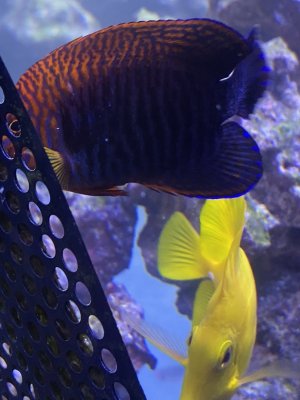
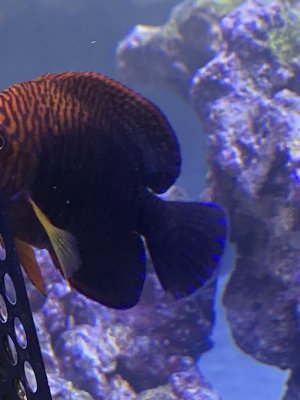
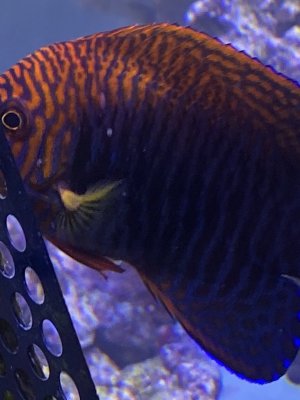
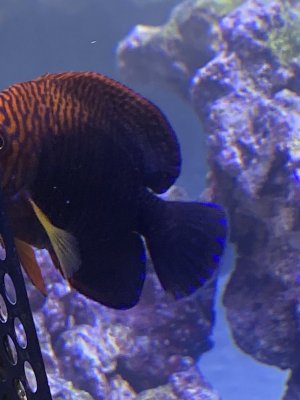
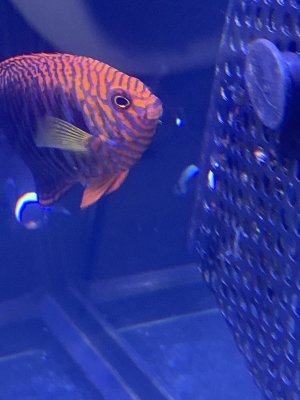
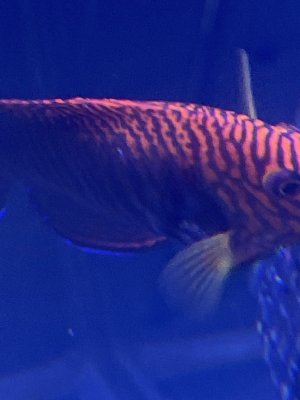
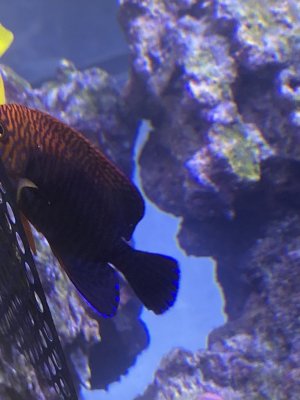
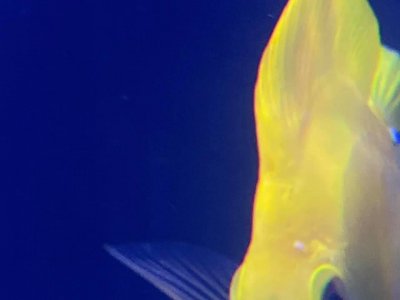








oversize UV.
Similar threads
- Replies
- 75
- Views
- 2,549
- Replies
- 12
- Views
- 269
- Replies
- 22
- Views
- 283
New Posts
-
-
Livestock LIVE Copepods Tigriopus Tisbe Apocyclops
- Latest: Reef By Steele
-
-


















